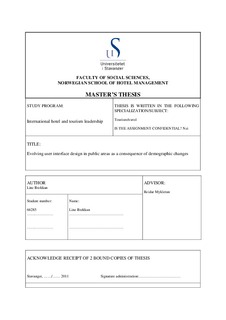| dc.description.abstract | Airports are rapidly getting more complex. They are in general undergoing rapid development with new sections added and new technology and information systems put into operation. The security is also becoming more rigours in terms of restrictions and regulations. Moreover, it can be experienced that airports are becoming more like shopping malls, filled with stores, cafés and restaurants. It can be perceived as a “landscape” of experiences. Simultaneously, societies all over the world are experiencing an aging population (“WHO,” 2012). The senior segment tend to have different needs than younger adults, and these needs can often be more complex (Alsnih & Hensher, 2003). This study focuses on seniors aged 55 and older. This is a generation born before the information revolution, and comparative studies have shown that people born before this period are more sensitive to the development of technology (Christopher Sze Chong, 2010). Similarly, the many effects of aging and environmental characteristics can also influence how the elderly interacts with technological devices, such as automated services, signs and boards and not at least, how they experience the more complex airports. The present thesis hence places its concern on the elderly segment and if they are experiencing any difficulties or obstacles in relation to the user interface design at Stavanger airport, Sola. The term user interface design has in this project been defined as the entire environment at the airport and reflects the security, personnel, cafés, seating area, information boards and signs. The present project follows a qualitative design, including methods such as participant observations and semi-structured interviews at Stavanger airport. One of the outcomes was that the subjects experienced difficulties with the use of automated services. However, there are no clear evidence that the elderly experiences any vital obstacles in relation to the security and interpreting signs and boards. | no_NO |
